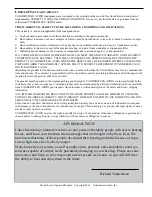
U
SER
A
DJUSTMENTS
13 Model Seven Operation Manual
14. Play tracks sixteen through twenty six and have an
assistant adjust pots #1 through #11 as before. For
your information the bands center frequencies are:
Pot# 1 2 3 4 5 6 7 8 9 10 11
Frq. 20 24 30 36 42 50 60 72 84 100 120
15. This procedure is half art and half science so do not try
to adjust every peak or dip all the way to 0dB even if
possible. Our studies and listening have shown that
adjusting all the peaks and dips to 0dB can cause a
non-musical sound with audible equalization effects.
Some rooms are very flat and the temptation to adjust
for perfectly flat will be great. Don’t do it, as it will
sound over equalized. Our ear/brain knows there are
standing waves in the room and can’t be fooled so all
we can do is reduce their amplitude. If after finishing
the final level and contour adjustments in the section
below you feel the sound is not engaging, go back and
carefully relax the corrections made. Start by backing
off any pot that was at maximum or minimum rotation
about one hour, as if it were a watch face.
Note: In most rooms because the surroundings are not
symmetrical it is quite common for the right and left
Level Control on the bass amplifier to be at different
settings. This is true even in rooms where the speakers
are placed symmetrically because of adjacent rooms or
wall construction differences. It is important for this
difference to remain when adjusting the sub-woofer
Level Control in the following section. For example:
the left Low Freq Control is at “0” because that is
what the calibration procedure calls for and the right
Low Freq Level may have ended up at “+2” during the
calibration procedure of the right speaker. This differen-
tial must always remain. We have calibrated dozens of
rooms over the years and have observed that the bass
change is minimal but the midrange becomes noticeably
more open and three dimensional.
Do not try to set the Room Compensation Controls by ear. Due to the complex interac-
tions of the controls, you will only succeed in compromising the inherent accuracy of the
speakers. Unless adjusted using the preceding method, the eleven Room Compensation
Controls should be left straight up.
L
OW
-
F
REQUENCY
L
EVEL
Set the low-frequency contour control to minimum (#1)
and verify that all 11 room compensation bands are set up.
Select a clean jazz recording with a stand-up bass scaling
up and down. Adjust the Low-Frequency Level controls
on the speakers until the transition from the subwoofer to
the upper part of the speaker is seamless and linear. The
levels on both speakers should maintain any difference
discovered during Room Compensation adjustments.
C
ONTOUR
A
ND
H
IGH-
F
REQUENCY
L
EVEL
C
ONTROLS
Three controls on the Model Seven’s input plate allow
you to tailor the characteristics of the speaker’s bass and
treble response to suit the listening environment and your
personal taste. The High-Frequency Level and High-
Frequency Contour controls adjust the output level and
response characteristics of the rear mounted tweeter while
the Low-Frequency Contour control adjusts the Q of the
subwoofer section. Since these controls alter the perform-
ance of the speaker to match your personal taste, they
should be adjusted by ear using well recorded, accurate
jazz recordings. All the instructions for adjusting these
controls assume that the Low-Frequency Room Compen-
sation controls have been set, and the Low-Frequency
Level adjusted for linear response. It is also assumed that
the speakers are positioned according to previous instruc-
tions, that the cones are installed with the tilt required to
aim the speakers at your listening height and that the high-
pass crossover is in place and properly configured.
Before we individually address each of these controls
and their use, we want to point out that they are not sub-
stitutes for tone controls. One should be careful to select
known high quality recordings with recognizable instru-
ments to eliminate confusion and the possibility of chas-
ing variations in recordings. This could be like watching
a cat chase its tail! A good jazz recording with a stand up
bass works best. Preamplifier tone controls are designed
to withstand thousands or even tens of thousands of ad-
justments and are the best way to compensate for
If after finishing the final level and contour adjustments in the section below you feel the
sound is not engaging, go back and carefully relax the corrections made. Start by backing
off any pot that was at maximum or minimum rotation about one hour, as if it were a
watch face.




















